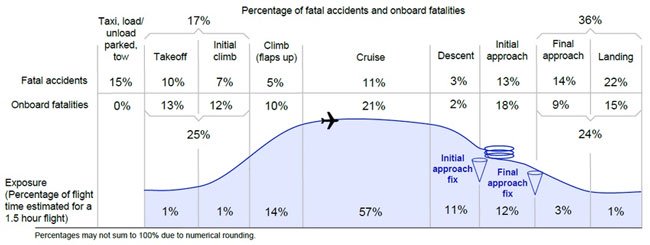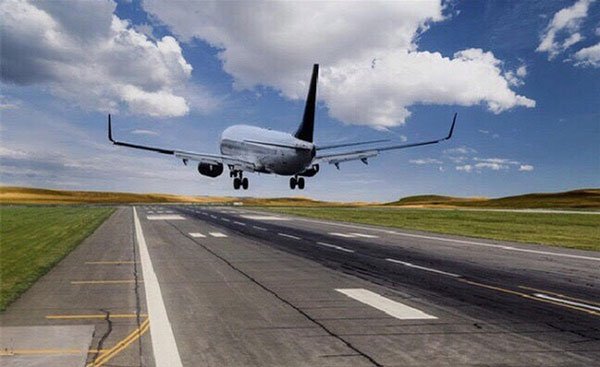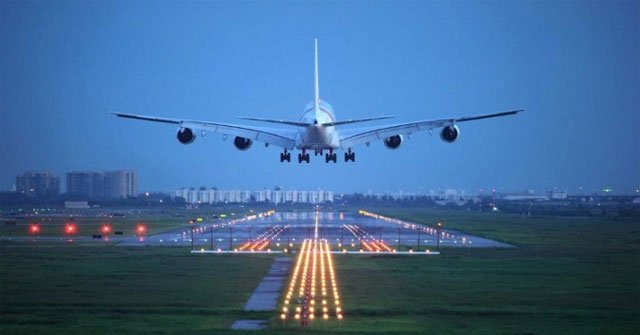Why is the process of flight taking off and landing the most dangerous?
According to Boeing, a 90-minute flight is divided into 8 stages, of which takeoff and landing are known as the two most dangerous stages.
After taking a look at all of the commercial aircraft crashes that occur every year and sort by the time of the accident, Boeing gave the chart below.

Two stages of takeoff and altitude, accounting for only 2% of the flight time, but the accident rate was 14%. The altitude maintenance phase accounted for half of the flight time but the incidence of accidents was lower, at only 11%. The highest chance of having an accident, up to 49%, falls during the descent and landing takes up only 4% of the flight time.
When the aircraft is at an altitude of 10,000m, if an incident occurs, the pilot will have a long time to resolve. In the event that the aircraft's engine is completely off, it will not be able to fall immediately to the ground, it may even glide in the airflow. In that state, the aircraft will descend at an altitude of about 1,600m for every 16,000m moving forward giving pilots about 8 minutes to be able to find a safe landing location.

The crash rate of the takeoff and landing stages is high because at that time, the aircraft will be low altitude and slow, so when the pilot problem does not have enough time to react. . The take-off of commercial aircraft takes only about 30 to 35 seconds. If something goes wrong, it doesn't have enough time to make a decision to continue taking off or try to land the plane.
In most cases, the pilot will decide to continue to take off because stopping taking off while traveling on the runway at speeds over 160km / h is very difficult. You can only do that before the aircraft reaches the speed limit allowed, otherwise not impossible.

If the plane doesn't take off it will go all the way. Usually, at the end of the runway is a field.
So what makes the landing process much more dangerous than taking off?
Quite simply, when an aircraft moves slowly and is in the process of landing on a runway, it is more susceptible to impact than takeoff. A wind or something like that can hit a plane hard, an unfortunate situation will also lead to an accident.
However, among the vehicles, aircraft is still the most vehicles.
- In-flight Wi-Fi and things you need to know before you use
- Why is the passenger door up and down always on the left side of the plane?
You should read it
- Will there be unmanned aircraft approaching the Mars atmosphere in the future?
- 5G can interfere with aircraft's automatic landing system
- Why does lightning do not affect aircraft while flying?
- Why does the phone have to be in flight mode when taking off and landing?
- The largest aircraft in the world looks like a 'butt' taking off for the first time
- How to repaint an entire aircraft?
- Air turbulence while flying is not as scary as you think
- Why is the airplane wing not so high in flying tape?
- Surprising facts about aircraft tires not everyone knows
- Special cable, only a few countries in the world can produce it
- Looking back at 27 years of development of the Boeing 777 - the best aircraft in the world
- Why are there so many planes in the sky at the same time but they never collide with each other?
May be interested

Having phlegm in the throat is what disease? How to treat phlegm in the throat?

Differentiate between PVC and PE food wrap, which is safe and best

The most impressive cosmic images 2019

Top 3 most impressive hallucinations in 2019, will make you lose confidence in reality

14 rare 'super powers' of humans

What types of masks are resistant to fine dust?






 Why does the phone have to be in flight mode when taking off and landing?
Why does the phone have to be in flight mode when taking off and landing? What is landing page in SEO?
What is landing page in SEO? How to design a beautiful landing page
How to design a beautiful landing page The plane had to make an emergency landing because of a laptop
The plane had to make an emergency landing because of a laptop Top 7 best landing page builders
Top 7 best landing page builders 5G can interfere with aircraft's automatic landing system
5G can interfere with aircraft's automatic landing system